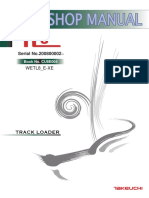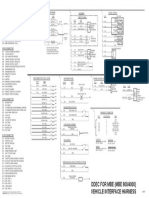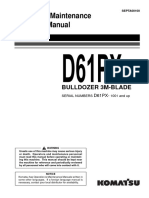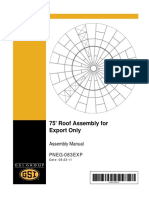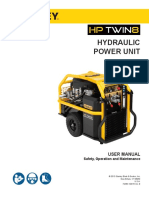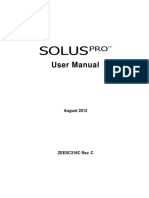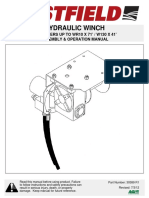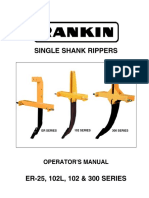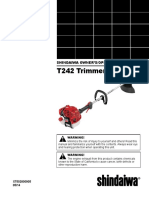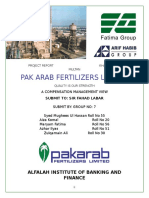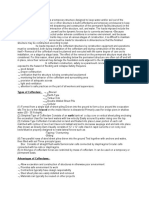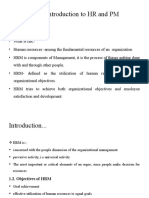MB10 Stanley
MB10 Stanley
Uploaded by
Daniel PimsaCopyright:
Available Formats
MB10 Stanley
MB10 Stanley
Uploaded by
Daniel PimsaOriginal Title
Copyright
Available Formats
Share this document
Did you find this document useful?
Is this content inappropriate?
Copyright:
Available Formats
MB10 Stanley
MB10 Stanley
Uploaded by
Daniel PimsaCopyright:
Available Formats
MB10
MOUNTED
HYDRAULIC BREAKER
USER MANUAL
Safety, Operation and Maintenance
© 2017 STANLEY Black & Decker, Inc.
New Britain, CT 06053
U.S.A.
76818 10/2018 Ver. 8
TABLE OF CONTENTS
SAFETY SYMBOLS..................................................................................................................................................4
SAFETY PRECAUTIONS........................................................................................................................................5
TOOL STICKERS & TAGS.......................................................................................................................................8
OPERATION.............................................................................................................................................................9
TROUBLESHOOTING...........................................................................................................................................15
MAINTENANCE......................................................................................................................................................16
CHARGING THE ACCUMULATOR.......................................................................................................................17
WEAR TOLERANCES............................................................................................................................................18
PROPER CARE OF TOOL BITS...........................................................................................................................19
FLOW TEST PROCEDURES................................................................................................................................23
DEFINITION OF TERMS.......................................................................................................................................25
SPECIFICATIONS..................................................................................................................................................26
ACCESSORIES......................................................................................................................................................27
MB10 POWER CELL ILLUSTRATION..................................................................................................................28
MB10 POWER CELL PARTS LIST........................................................................................................................29
MB10E00 HOUSING PARTS.................................................................................................................................30
MB10E05 / MB10E09..............................................................................................................................................31
MB10S02 CRADLE BRKT ILLUSTRATION & PARTS LIST................................................................................32
MB10S05 SKID STEER EXCHANGE BRKT.........................................................................................................33
To fill out a product warranty validation form, and for information on your warranty,
visit www.stanleyinfrastructure.com and select the Company tab > Warranty.
Note: The warranty validation record must be submitted to validate the warranty.
SERVICING: This manual contains safety, operation and routine maintenance instructions. STANLEY Infrastructure
recommends that servicing of hydraulic tools, other than routine maintenance, must be performed by an authorized
and certified dealer. Please read the following warning.
SERIOUS INJURY OR DEATH COULD RESULT FROM THE IMPROPER REPAIR OR
SERVICE OF THIS TOOL.
REPAIRS AND / OR SERVICE TO THIS TOOL MUST ONLY BE DONE BY AN
AUTHORIZED AND CERTIFIED DEALER.
For the nearest certified dealer, call STANLEY Infrastructure at (503) 659-5660 and ask for a Customer Service Representative.
MB10 User Manual ◄ 3
SAFETY SYMBOLS
Safety symbols and signal words, as shown below, are used to emphasize all operator, maintenance and repair
actions which, if not strictly followed, could result in a life-threatening situation, bodily injury or damage to equipment.
This is the safety alert symbol. It is used to alert you to potential personal injury
hazards. Obey all safety messages that follow this symbol to avoid possible
injury or death.
This safety alert and signal word indicates an imminently hazardous situation
which, if not avoided, will result in death or serious injury.
This safety alert and signal word indicates a potentially hazardous situation
which, if not avoided, could result in death or serious injury.
This safety alert and signal word indicates a potentially hazardous situation
which, if not avoided, could result in death or serious injury.
This signal word indicates a potentially hazardous situation which, if not avoided,
may result in property damage.
This signal word indicates a situation which, if not avoided, will result in damage
to the equipment.
This signal word indicates a situation which, if not avoided, may result in damage
to the equipment.
Always observe safety symbols. They are included for your safety and for the protection of the tool.
LOCAL SAFETY REGULATIONS
Enter any local safety regulations here. Keep these instructions in an area accessible to the operator and
maintenance personnel.
4 ► MB10 User Manual
SAFETY PRECAUTIONS
WARNING
WARNING
Do not operate the breaker unless the
following safety instructions have been
thoroughly read and understood! Read this
manual before installing, operating or
maintaining this equipment.
Read the Manual
• A flying projectile from the breaker, breaker
tool, rock or other material may enter the
operator's compartment and cause serious
or fatal injury to the operator. Personal
protection equipment must be used.
• A flying projectile from the breaker, breaker
tool, rock or other material may cause Wear Breathing
serious or fatal injury to bystanders. Never Protection
operate the breaker when bystanders are in
the work area.
• On some machines/carriers, the breaker
can enter the operator's compartment if it
breaks loose and swings toward the
operator. Make sure that suitable impact
shields are used when operating the Wear Hearing
breaker with this type of equipment. Protection
• Do not operate the breaker unless all safety
decals described in this manual are in
place. The decals must be inspected
periodically to ensure that all wording is
legible. The decals must be replaced if
illegible. Replacement decals can be
obtained from your authorized Stanley Wear Eye
Distributor. Protection
• When operating the breaker you must use
ear protection, eye protection, and
breathing protection.
MB10 User Manual ◄ 5
SAFETY PRECAUTIONS
Tool operators and maintenance personnel must always means a backhoe or excavator or similar equipment
comply with the safety precautions given in this manual used to operate the breaker.
and on the stickers and tags attached to the tool and • Ensure that all maintenance procedures recom-
hose. mended in this manual are completed before using
These safety precautions are given for your safety. Re- the equipment.
view them carefully before operating the tool and before • The operator must not operate the breaker or carrier
performing general maintenance or repairs. if any people are within the area where they may be
Supervising personnel should develop additional pre- injured by flying debris or movement of the equip-
cautions relating to the specific work area and local ment.
safety regulations. If so, place the added precautions in • Know the limits of your equipment.
the space provided in this manual.
• Establish a training program for all operators to en-
The MB10 Mounted Hydraulic Breaker will provide safe sure safe operation.
and dependable service if operated in accordance with
the instructions given in this manual. Read and under- • Warning: Use of this tool on certain materials during
stand this manual and any stickers and tags attached demolition could generate dust potentially contain-
to the tool and hoses before operation. Failure to do so ing a variety of hazardous substances such as as-
could result in personal injury or equipment damage. bestos, silica or lead. Inhalation of dust containing
these or other hazardous substances could result
Check the rules and regulations at your location. The in serious injury, cancer or death. Protect yourself
rules might include an employer's work safety program. and those around you. Research and understand
Regulations may identify hazards such as working the materials you are cutting. Follow correct safety
around utility supply lines or hazardous slopes. procedures and comply with all applicable national,
BE THOROUGHLY TRAINED BEFORE state or provisional health and safety regulations
OPERATING THE UNIT ALONE relating to them, including, if appropriate arranging
for the safe disposal of the materials by a qualified
• Operator training must start in an area without by- person.
standers and use all the controls until he/she can
control the machine fully under the conditions of the • Do not operate the tool unless thoroughly trained or
work area. under the supervision of an instructor.
• When learning to operate a machine, do so at a slow • Become familiar with the carrier controls before op-
pace. erating the carrier and the breaker.
• When operating the breaker you must use ear pro-
KNOW THE WORK CONDITIONS
tection, eye protection, and breathing protection.
• The operator must know any prohibited uses or work
• While learning to operate the breaker and carrier, do
areas for the machine. For example, excessive
so at a slow pace. If necessary, set the carrier mode
slopes and poor or dangerous terrain conditions
selector to the slow position.
must be avoided.
• Make sure all controls (levers and pedals) are in the
OBEY SAFETY RULES NEUTRAL position before starting the carrier.
• Operate the breaker in accordance with all laws and • While operating the breaker and carrier, keep hands
regulations which affect you, your equipment, and and feet on the controls at all times.
the worksite.
• Before leaving the carrier, always lower the boom
• Do not operate the breaker until you have read this and insure the carrier is stable. Never leave the ma-
manual and thoroughly understand all safety, opera- chine with the engine running. ALWAYS ENGAGE
tion and maintenance instructions. THE PARKING BRAKE.
• The operator must be familiar with all prohibited • Stop the engine before attempting to make any re-
work areas such as excessive slopes and danger- pairs, adjustments or servicing to either the carrier
ous terrain conditions. or the breaker.
• Do not operate the breaker until you have read the • Do not operate the tool at oil temperatures above
carrier equipment manual and thoroughly under- 210° F / 99° C. Operation at higher temperatures
stand all safety, operation and maintenance instruc- can damage the internal components of the breaker
tions. The word “carrier”, as used in this manual, and carrier and will result in reduced breaker per-
6 ► MB10 User Manual
SAFETY PRECAUTIONS
formance.
• Do not operate a damaged, leaking, improperly ad-
justed, or incompletely assembled breaker.
• Do not modify the breaker in any manner.
• Use only tool bits supplied by STANLEY. Use of tool
bits supplied by another manufacturer may damage
the breaker and will void the warranty.
• To avoid personal injury or equipment damage, all
breaker repair, maintenance and service must only
be performed by authorized and properly trained
personnel.
• If you do not understand how to safely operate your
breaker, contact an authorized STANLEY Dealer for
assistance.
• Keep this manual with the breaker.
• Do not operate this equipment if you are taking med-
ication which may affect your mental judgement or
physical performance.
• Do not operate this equipment if you are under the
influence of drugs or alcohol.
MB10 User Manual ◄ 7
TOOL STICKERS & TAGS
Refer to the Parts Illustration page in this manual for proper placement of stickers.
70929
Model Number Sticker
USA
Made in
of Global Components 47352 47351
Lift Point Sticker Composite Warning Sticker
66764
Made in USA Sticker
74705
STANLEY Logo Sticker
70972
Grease Sticker
70754
Nitrogen Sticker 200-PSI
70971
Information Sticker for MB10S02 / S05
70961
Information Sticker for MB10E00 / E05 / E09
8 ► MB10 User Manual
OPERATION
PRE-INSTALLATION INSTRUCTIONS
CARRIER SIZE
Check the Specifications section of this manual to de-
termine correct carrier size, hydraulic flow and pressure
requirements.
If hydraulic pressure, hydraulic back-pressure, hydraulic
flow or excavator weight class are exceeded, the tool
warranty is void. Grease
This Area
EXISTING EQUIPMENT HYDRAULICS VS. of Bit
APPLICATION ATTACHING KITS
Using existing equipment hydraulic auxiliary systems
for operating hydraulic tools could cause problems for
the hydraulic tool and the hydraulic system if not set up 250 mm/10 in.
properly. Simply plugging into the hydraulic system with-
out confirming pressure and flow to the hydraulic tool is
Tool Bit
not a good practice. Spare spool valves, dipper circuits,
etc., are just a few examples of easily accessible hy-
draulic circuits which could prove to cause problems for
hydraulic tool usage.
TEST THE HYDRAULIC SYSTEM
1. Have your STANLEY dealer test the carrier hydrau-
lic system to make sure the system is operating at
the manufacturers specified capacity and pressure
ratings.
2. Be sure the fluid in the hydraulic system is clean.
3. Check the hydraulic filter. Replace the filter if dirty or
deteriorated.
4. Have your STANLEY dealer test the circuit to which
the breaker will be connected to make sure that the
circuit is supplying the specified flow and pressure Grease Fitting
rating for the breaker. See the Specifications section
of this manual.
PRE-OPERATION PROCEDURES
NITROGEN CHARGE
The breaker has been properly charged with nitrogen at
the factory and is ready to use.
TOOL BIT LUBRICATION
Grease the top 250 mm / 10 in. of the breaker tool bit be-
fore installing. During operation, the tool can be greased
through the grease fitting. Grease is required.
Make sure the tool bit is against the piston by placing the
tool bit against the ground and then putting down pres-
sure on the breaker. See the illustrations below.
MB10 User Manual ◄ 9
OPERATION
Greasing the tool bit without down pressure on the Always wear eye protection when installing or
breaker results in grease filling the space between removing the tool retaining pin.
the piston and the tool bit. When the breaker is next
activated, the piston will strike the grease at a speed
which will pressurize the grease resulting in seal and PROCEDURE
grease zerk failure.
1. After starting the carrier, warm-up the hydraulic sys-
tem at engine idle until hydraulic lines are warm to
Piston in down position, the touch.
pressurized by Nitrogen in 2. With the carrier at idle and the breaker suspended
accumulator in the air or with minimal down pressure, turn on the
breaker to gradually warm up its internal compo-
nents.
No gap between
tool bit and piston 3. When the hydraulic system and breaker are warm,
proceed with operation.
LONG TERM STORAGE
Tool bit pushed up 1. Remove the tool bit, clean the tool stop and the low-
against the piston er bushing. Thoroughly coat the surfaces of the tool
stop and the lower bushing with grease.
2. If hoses are attached to the breaker, install plugs
on the hose ends. If hoses are removed from the
Gap - grease will fill breaker, install plugs on the hose ends and install
plugs in the breaker IN and OUT ports.
this space
3. Store the breaker in a vertical position. Do not store
the breaker horizontally for extended periods.
Tool bit NOT pushed up
against the piston
SECURING THE TOOL BIT
1. The tool retainer is shipped installed in the breaker.
2. Drive out the tool retainer.
3. Grease the top area of the tool bit as shown in the
illustration on page 9.
4. Install the tool bit making sure the notch is aligned
with the lower body retainer pin holes.
5. Install the tool retainer.
LOW TEMPERATURE WARM-UP
10 ► MB10 User Manual
OPERATION
OPERATING THE BREAKER EXCAVATORS
PREPARATION FOR USE With the breaker tool in place on the material to be
worked, position the excavator so the dipper is at ap-
Read the section in this manual titled Pre-Operation Pro- proximately 45° and the breaker is almost vertical. The
cedures before operating a breaker. Failure to follow the tracks of the excavator should be in line with the boom
preparation instructions can result in severe damage to and the breaker.
the breaker and carrier and void the warranties of both.
POSITIONING THE CARRIER
BACKHOES
With the breaker tool in place on the material to be
worked, position the backhoe so the boom is halfway up
(45°) and the dipper holds the breaker almost vertical.
Lower the loader bucket until the weight is off the front
tires.
Apply down force.
POSITIONING THE BREAKER TOOL ON
THE WORK MATERIAL
Position the tool bit near the edge of the work material,
not in the center or far from the edge. Position the tool 6
– 18 inches (depending on the material) from the edge.
Breaking off smaller pieces of rock or concrete usually
accomplishes more than trying to break larger pieces.
Apply down pressure.
Apply down force to the boom/dipper until the rear of the
backhoe is raised off the ground. Rear tires and stabiliz-
ers should be off the ground so the total rear weight of
the backhoe is on the breaker tool. The breaker is more
efficient when adequate down force is applied.
Break near the edge.
On flat material or rock, the breaker should be vertical
or “curled” back slightly to direct the impact force down-
ward and toward the backhoe. This directs the force
back toward the edge of the work material. If the tool
is positioned in the center of the work, or too far from
the edge, the energy will be absorbed into the material
without cracking it. Do not run the breaker longer than
MB10 User Manual ◄ 11
OPERATION
15 – 20 seconds. If breakout does not occur within this
time, move the breaker to another position.
On flat material such as concrete runways, starting to
break in the middle of the material may cause vibrations
to be transmitted throughout the breaker and excavator
because the material has no place to break to. Always
try to start at a point which will permit the material to
break out.
MAINTAIN DOWN PRESSURE
Maintaining hard contact with the surface of the material
to be broken in addition to maintaining adequate “down Do not break continuously
force” is very important. Always keep “down pressure” in one place.
or “down force” on the point of the breaker by lifting the
wheels, tracks, or stabilizers slightly above the ground.
This method takes the “slack” out of the bracket and
boom pivots, and reduces the impact on the pivots in
the boom.
The operator needs to be constantly aware of the amount
of down pressure being applied and be able to adjust it Continuous penetration in the same area for lengthy
if necessary. Not enough down pressure results in low periods will create excessive temperatures at the tip
production and accelerates wear and tear on the equip- of the tool bit resulting in loss of temper (hardness)
ment. Too much down pressure may cause the breaker of the bit, mushrooming of the tip of the bit and may
housing to violently crash into the broken material when lead to failure of the bit.
“break-through” occurs.
In any breaking job, the operator should make every ef-
fort to “follow” the breaker with “down pressure” as the Use a “scoring” method of breaking when cracking
machine breaks farther into the material. The breaker the material becomes difficult. This technique involves
should be stopped as soon as “break-through” occurs or striking the rock or concrete at several places along a
if it is apparent that good solid blows are not occurring. line where you want the crack to occur. Most materials
break sooner when struck several places along a line
BREAKING than when struck repeatedly in one location. On each
The operator should note the sound of the blow when line, the breaker tool should be continually repositioned.
the breaker is running. With experience, the operator will Practice determines the best length of time to stay in
be able to tell the difference between a good solid blow one spot. (15 – 20 seconds) and how far to move the
and a hollow sounding blow. A hollow blow means that breaker tool.
solid blows are not occurring and breaker should be re-
positioned.
Continuous tool penetration usually does not do much
good. If the material does not break with 3 – 6 inches of
tool penetration, it usually won’t break with full penetra-
tion. The time used for additional penetration could be
better used to strike blows in another place.
Many materials do not respond well to continued ham-
mering in one place. The breaker tool should be repo-
sitioned on the work each time the tool penetrates but
does not crack the material.
Scoring with the breaker
12 ► MB10 User Manual
OPERATION
Breaker tool binding can cause erratic breaker opera- BLANK FIRING
tion and premature wear on the tool shank. Breaker tool
To understand “Blank Firing”, the operator needs to be
binding is caused by failure to direct the down force in
aware that the tool bit is able to drop down in the lower
the direction of the tool bit.
body cavity, far enough so that the piston cannot strike it,
when the tool bit is not in contact with the work surface.
“Blank Firing” occurs whenever the breaker is operating
and the piston is not able to strike the tool bit solidly or
not strike the tool bit at all. “Blank Firing” accelerates
wear and tear on breaker and carrier components and
may result in failure of one or more components. Exces-
sive “Blank Firing” may be considered equipment abuse
and may result in voiding warranties.
Break-through or difficult surface contact results in
“Blank Firing” when the material being broken fractures
and the tool bit is no longer in “hard contact” with the
material but is still pushed high enough in the lower body
cavity so that the piston can strike it. In this position, the
Breaker tool bit binding piston strikes the tool bit and the tool bit, in turn, is driven
against the retaining pins because it is not in sufficient
contact with the material to be broken. The energy is ab-
sorbed by the retaining pins, other breaker components,
and the carrier boom components. “Blank Firing” of this
type can be experienced in trench work where obtain-
ing striking contact with the work surface is difficult or
Do not pry with bit and breaker. The tool bit may
the wrong tool bit is used, or in flat rock work where the
break causing injury.
operator fails to stop operation of the breaker when slip-
page, fracturing or material break-through occurs.
Excessive side force cocks the tool in its bore, prevents “Blank Firing” as a result of operator error occurs when
proper movement and causes premature tool shank the tool bit is not in contact with the work surface to be
and bushing wear. Since the breaker tool bit must be broken and is allowed to drop down in the lower body
pushed up into the breaker to operate, a binding tool cavity so that the piston is not able to strike it. Instead,
prevents the breaker from operating correctly. Binding the downward movement of the piston will be stopped
also causes the tool bit and tool bushings to seize and by an internal oil cushion located at the bottom of the
often results in breakage of one or more breaker com- piston’s stroke and the energy of the piston will be ab-
ponents. sorbed by breaker components and excavator boom
components. “Blank Firing” of this type can be experi-
Always direct the down pressure force in a line toward
enced when the operator fails to stop operation of the
the point of tool contact with the work.
breaker when the material fractures or material break-
Moving rocks with the tool bit is another method of bind- through occurs, or during re-positioning of the breaker.
ing the tool bit. This practice should be avoided as it may
While “Blank Firing” cannot always be avoided, it can be
cause tool bit failure.
kept to a minimum by avoiding the above conditions as
Rebar reinforced concrete introduces the problem of much as possible.
concrete chunks being held together by the rebar after
the concrete has been broken. The best approach to this
problem is to use a chisel point tool which permits cut-
ting the rebar with the breaker. Another method is to pe-
riodically cut the rebar with an oxy-acetylene torch
MB10 User Manual ◄ 13
OPERATION
UNDERWATER USAGE GREASE THE BIT
Underwater usage of the breaker will cause damage Grease should be applied to the upper end of the break-
to internal components. Even if the breaker is partially er tool bit each time it is installed. Thereafter, the tool
submerged, water is introduced to an area between the should be greased at the fitting to reduce wear in the
tool bit and piston. On the piston down cycle, the water lower body and bushings of the tool. See Greasing The
becomes compressed and damages adjacent compo- Tool Bit in the sections titled Pre-Operation Procedures.
nents.
Do notDO NOT USE
use underwater UNDERWATER
without supplying air to breaker.
No part of the breaker may be submerged in water.
Underwater usage of the breaker will cause internal
damage to the breaker. Consult STANLEY for
modifications and specific warranty coverage if you
have an underwater requirement.
14 ► MB10 User Manual
TROUBLESHOOTING
This section describes how to find and resolve problems users may experience. If a situation occurs that is not
covered, call your STANLEY Customer Service representative for assistance.
Inspecting the tool or installing parts with the hydraulic hoses connected can result in severe personal injury
or equipment damage. To prevent accidental startup, disconnect the hydraulic power before beginning any
inspection or installation task.
If symptoms of poor performance develop, the following chart can be used as a guide to correct the problem.
When diagnosing faults in operation of the tool, always check that the hydraulic power source is supplying the
correct hydraulic flow and pressure to the tool as listed in the table below. Use a flowmeter known to be accurate.
Check the flow with the hydraulic oil temperature at least 80 °F/27 °C.
PROBLEM CAUSE SOLUTION
Breaker will not fire. Low hydraulic oil level. Fill reservoir.
No flow to breaker. Have hydraulic circuit tested by
Main relief set low. authorized dealer/distributor per
approved procedure.
Internal damage. Have unit serviced by an authorized
dealer/distributor.
Damaged quick couplers. Replace.
Breaker runs slowly. Low hydraulic flow Have hydraulic circuit tested by an
Excessive heat build up. authorized dealer/distributor per
approved procedure.
Excessive nitrogen pressure. Have unit serviced by an authorized
Internal leakage. dealer/distributor.
Breaker runs erratically. Low or excessive back-pressure. Have carrier serviced by an
Damaged switch or connection. authorized dealer/distributor.
Relief set too low.
Internal damage.
Tool binding. Add grease to tool shank. Do not
pry while operating.
Breaker runs but at reduced power. Low accumulator charge. Have unit serviced by an authorized
Excessive back-pressure. dealer/distributor.
Relief set too low.
Breaker leaks oil around tool bit and Lower seals failed. Have unit serviced by an authorized
tool bushing. dealer/distributor.
Hydraulic system overheats. Main relief set low. Have unit serviced by an authorized
Insufficient cooling capability in dealer/distributor.
hydraulic circuit.
Line/hose size too small.
Excessive back-pressure.
MB10 User Manual ◄ 15
MAINTENANCE
DAILY MAINTENANCE CHECKS
Check for loose or missing fasteners. Tighten or replace
as needed.
Inspect tool retaining pins and pockets for wear.
Check for hydraulic leaks at all fittings and hoses. Re-
place any defective hoses.
Apply grease to the grease fitting in the lower body each
morning. Grease as needed throughout the work day.
TOOL STOP AND LOWER BUSHING
Inspect the tool stop and lower bushing for excessive
galling and metal pickup on the tool bit. Also check for
cracks. If cracks are present, the part must be replaced.
The extent of wear of the tool stop and lower bushings
and the tool bit can be checked by moving a NEW tool
bit back and forth and measuring the gap between the
tool bit and the lower bushing. If the gap is more than
.250 in./6 mm, the upper bushing, lower bushing and
tool bit should be replaced. A gap in excess of .250 in./6
mm will cause damage to the piston. Do not just replace
the tool bit or the lower bushing individually as this will
result in premature wear of the replaced component. It is
recommended to replace ALL worn components.
16 ► MB10 User Manual
CHARGING THE ACCUMULATOR
The tools required to charge the breaker accumulators 5. If the pressure is correct, unscrew the gauge to re-
are the 505232 charge hose assy and the 76485 ac- tract the plunger. Then, loosen and remove the tes-
cumulator tester which are used with other STANLEY ter from the charge valve. If the pressure is not cor-
model breakers. When charging the accumulators, rect, proceed to Step number 6.
make sure the tools and charge valves are clean. Dirt Note: When disengaging the tester a "POP" of nitro-
can contaminate the charge valves and cause leakage. gen is normal.
1. Remove the protective plug from the accumulator 6. Connect the charge hose assembly to the charg-
charge valve. Note: There is one accumulator on ing valve on the tester. Make sure the valve on the
this breaker; the upper accumulator. charge hose assembly is closed. Open the valve on
2. Hold the chuck end of the tester and turn the gauge the nitrogen bottle.
fully counter clockwise to ensure the plunger inside 7. Very slowly open the valve on the charge hose as-
the chuck is completely retracted. sembly and slowly meter the nitrogen into the break-
3. Screw the tester into the breaker charge valve by er charge valve until the tester reads the correct
turning the chuck. Do not use the gauge for turn- charge pressure (200 psi).
ing as this will advance the plunger in the chuck. 8. When the correct pressure is obtained, close the
Tighten the chuck lightly against the breaker charge valve on the charge hose assembly and on the nitro-
valve. gen bottle. Unscrew the gauge to retract the plung-
4. Turn the gauge clockwise to advance the plunger er. Loosen and remove the tester from the charge
until a pressure is indicated on the gauge. Do not valve. Before replacing the protective plug, inspect
overtighten. the plug o-ring. If damaged or deformed, replace the
plug. Apply Loctite™ 243 to plug and cap.
Upper Accumulator
CHARGE PRESSURE SPECIFICATION
Upper Accumulator: 200 PSI +/- 10 PSI
13.7 BAR +/- .7 BAR
Nitrogen Bottle
(Locally obtained)
Charge Hose Assembly
P/N 505232
(Includes Gauge, Valve, Hose
and Charge Valve Adapter)
Tester
P/N 76485
MB10 User Manual ◄ 17
WEAR TOLERANCES
NEW REJECT LIMIT
LOWER BUSHING (Item 21, Pg28) Measure at Center
2.880 in. / 73.1 mm 3.000 in. / 76.2 mm
LOWER BUSHING
TOOL STOP (Item 20, Pg 28)
A) 2.880 in. / 73.1 mm A) 3.000 in. / 76.2 mm A Wear Areas
Inside Diameter Inside Diameter
B) .600 in. / 15.2mm Depth B) .480 in. / 12.2 mm Depth C = Measure at 1.2in./30mm C
TOOL STOP
RETAINER PIN (Item 30, Pg 28)
1.845 in. / 46.8 mm Out- 1.745 in. / 44.3 mm Outside Measure Diameter
side Diameter Diameter
PISTON
(Item 23, Pg 28) RETAINER PIN
.450 in. / 11.4 mm Depth .410 in. / 10.4 mm
Wear
Wear Limit
Limit
NewPart
New Part
PISTON
IMPORTANT
LOWER BUSHING
To increase the life of the lower bushing, remove the bushing after normal wear has devel-
oped and rotate the bushing 90° and lock into the second slot. Normal wear on the bushing
is usually found from front to back, by rotating the bushing 90° will add additional life to the
bushing. In addition to rotating the bushing, it is also symmetrical and can be flipped end 90° SLOT ROTATION
to end and again rotated 90° resulting in even longer life.
TOOL STOP
To increase the life of the tool stop, remove the tool stop after normal wear has developed
and rotate the tool stop 90° and lock into the second slot. Note: the tool stop is not sym-
metrical and can not be flipped from end to end.
18 ► MB10 User Manual
PROPER CARE OF TOOL BITS
Tool bits are made and heat treated to specification. METAL-TO-METAL CONTACT
Tool bits, however well made, are wear parts, and are Extreme caution should be used to avoid scratches or
used in the most destructive applications. Even when gouges on the surface of the tool. These areas create a
the hydraulic breaker is used properly, and the operator stress concentration Metal-to-Metal Contact point, thus
is an experienced one, a tool bit may become damaged. weakening the tool.
When a tool bit has been damaged, it is useful to de-
Another form of metal-to-metal contact is galling, which
termine the cause immediately in order to prevent the
usually occurs from the lack of lubrication. Special care
damage from occurring again.
should be taken to keep the tool shank lubricated every
All STANLEY tool bits are machined and hardened for two (2) to three (3) hours.
maximum performance. Care must be taken to maintain
Steel failures that were caused by surface damage take
the tools original condition for optimum productivity and
two main forms. The simplest form is caused by deep
life expectancy. It is not uncommon for an operator who
scratches on working steel surface. The broken surface
is unfamiliar with using a hammer to break a point. This
has a shell pattern around the starting point of failure,
is part of the learning experience.
similar to the one in the fatigue failure. The other parts of
Listed below are several methods to determine tool fail- the broken surface are brittle. These failures work slowly
ure and will quickly aid in warranty determination. through the steel until it suddenly parts completely.
TOOL FAILURE NOT COVERED The second form of failure caused by surface damage
occurs when there are deep scratches on working steel
UNDER WARRANTY surface and there was also excessive bending stress.
BLANK FIRING OR FREE RUNNING The broken surface also shows the shell pattern, but the
other parts of the broken surface are brittle and usually
This occurs when the tool is not in proper contact with
have a “lip” like that in a stress failure.
the work, thus causing the energy produced by the ham-
mer to be concentrated on the tool retainer(s) and the
retainer slot(s) on the tool itself. Caution should be used
to prevent the hammer from sliding off slanted surfaces
or when breaking through thin material.
The illustration below is typical of the kind of breakage
that occurs from excessive blank firing.
WORN-OUT FRONT BUSHING(S) OR
RETAINER PIN(S)
Worn-out front bushing(s) will cause the tool to become
misaligned inside the hammer. This misalignment will
cause uneven contact between the piston and tool, thus
causing stress to concentrate on one particular area of
the tool. This can also cause the tool to bind inside the
hammer. Call your dealer for acceptable wear allow-
ances.
Worn-out retainer pin(s) will cause uneven loading on
the pin(s) themselves, causing failure of the tool or re-
tainer pin(s). This will also cause excessive wear to the
front bushing(s).
MB10 User Manual ◄ 19
PROPER CARE OF TOOL BITS
In its most extreme forms, the combination of surface
damage and severe bending can quickly break even the
best working steels.
The illustrations below show examples of severe stress
breaks.
CORROSION
Tools should be greased and stored out of the weather.
Corrosion tends to accelerate the fatigue fractures of the
tool.
MUSHROOMING
PRYING Driving the tool into a hard material for a long period of
This is the most common cause of tool failure. Even time generates an intense heat, indicated by a blue tone
when there is no surface damage, the stress from pry- just above the point. This will soften the steel and cause
ing can easily break a working steel. This kind of failure the point to fold over or mushroom the end of the tool.
generally results from any type of side pressure such as Avoid hammering in one location for too long. If material
an incorrect breaking angle or from using the tool to re- does not break after a short period (approximately 15 to
position material. The tool should not be used as a pivot 20 seconds), reposition the tool.
point when repositioning the carrier. The power gener-
ated by the carrier will far exceed the strength of the tool.
If the overheated steel is suddenly cooled by being
dipped in standing water, for example, the metal will
harden and become brittle. These are some examples
of failure caused by temper changes occurring on the
Similar failures can also occur when the steel is used
job.
with extreme down pressure, and the steel repeatedly
slips off the work at an angle, or the material, itself
moves from under the working steel.
As the next illustration shows, fatigue failures take many
forms, but they all exhibit similar features. Generally, the
broken surface is brittle and has a “lip” like that in the
bending failure, even though, in some cases, the lip has
been broken.
20 ► MB10 User Manual
PROPER CARE OF TOOL BITS
TOOL FAILURE COVERED UNDER
WARRANTY • Failures in this area are usually the result
of blank firing, worn bushing(s), worn re-
INTERNAL MATERIAL FLAW tainer pin(s) or the lack of lubrication.
This failure occurs when a foreign material is rolled into • Failures in this area are usually the result
of worn retainer pin(s) or blank firing.
the steel during the manufacturing process, causing an
imperfection in the internal material flaw grain. The re-
sult is an inherent weakness in the tool shank and even-
tual breakage.
• Failures in this area are usually the result
The fatigue failure is started by the defects within the tool of prying, metal-to-metal contact or corro-
sion. Prying failures often exhibit a shell-
bit. The broken surface exhibits a shell pattern around like formation near the edge of the steel
the starting point of failure, like that in the fatigue failure. diameter where the break began, and a
The other parts of the broken surface are brittle. “tail” opposite that where the remaining
steel bent and tore.
This is the only kind of tool bit failure that is always
covered under warranty.
• Failures in this area are usually the result
of heat build-up, mushrooming, or improp-
er contact with the work.
As a rule, working steel failures can be diagnosed by
looking at the break itself, and at the place on the steel
where the break occurred. Discoloration, like “rainbow”
effects or blue bands, is the result of extreme heat.
Look for surface cracks, galling, or gouge marks. Breaks
that start as surface damage have a “sea shell” pattern,
with the damaged spot at the center. A large “sea shell”
indicates a slow growing break; a small one indicates
one compounded by side stress.
Stress failures start small, and spread into the center
of the steel. In a stress failure, the coarser the grain,
the greater the stress was, and the more rapid was the
failure.
MB10 User Manual ◄ 21
PROPER CARE OF TOOL BITS
STANLEY Breakers are available with several different
types of tool bits. The most common are the conical,
chisel and the blunt. Each of these working steels has
its own purpose as described below:
To obtain the maximum production from the breaker, it
is important to select the proper working steel. Consult
your STANLEY representative for assistance in select-
ing the proper working steel for your application.
CONICAL
This is by far the most popular
working steel. It is a general
purpose point used to break
anything from concrete to hard
rock. Its pencil-type point is
used to fracture the material.
The tool is best where penetra-
tion speed is important.
CHISEL
This style of point is used gen-
erally used for trench work,
where a controlled break is re-
quired, and for rock breaking
on materials with a definite line
of cleavage. A chisel bit also
works well in softer concretes
where a moil might penetrate
quickly, but not cause a frac-
ture line.
BLUNT
This flat type of point is used to
break softer material such as
coal or shale. A moil or chisel
will tend to punch holes in this
type of material, where a flat
blunt will shatter the material.
It is also useful when break-
ing irregularly shaped material
where its broad tip makes it
easier to position.
22 ► MB10 User Manual
FLOW TEST PROCEDURES
The correct performance of this procedure will verify if the flow meter begins to decline rapidly. Locate the
the auxiliary circuit of the carrier is adequate to properly tools operating system relief pressure in the specifi-
operate a STANLEY attachment. cation section in the manual. Adjust attachment re-
This procedure is generic in form. It is the end users lief to specification.
responsibility to ensure that this procedure will work with Note: The relief valve pressure must be greater than
his specific type of equipment. the operating pressure of the attachment and three
If an adequate flow meter is not available contact your times the back-pressure. Never use the relief valve
STANLEY distributor for assistance. to control the flow rate in the circuit. Cracking pres-
sure means the loss of 4 or more GPM.
TEST PROCEDURE Record the relief cracking pressure psi.
1. With the auxiliary circuit (or kit) completely installed Example:
connect the flow meter between the tool inlet and
outlet hoses. Operation pressure of a breaker is 2700 psi. Back-pres-
sure is 150 psi. A good rule to follow when setting the
Note: Always use the hoses that are supplied for the relief, multiply the back pressure by 3 then add this num-
attachment and make sure the machine hydraulic ber to the operation pressure of the attachment.
oil is between 90 to 120 °F. This will assure correct
readings and adjustments. Operating Pressure 2700 psi
2. With the machine setting at the mode that’s going to Back-pressure 450 psi
be used to operate the attachment record the GPM Operating pressure of the tool 3150 psi
_____. The relief valve setting must be greater than the estimat-
Locate the correct flow for the attachment in the ed operating pressure of the tool. If the setting is lower,
manual under the specification section. Adjust the damage to the circuit may occur. Excess heat will be
machine to the correct GPM. generated in the circuit which will damage the attach-
Note: If possible, always set the machine to the high- ment and carrier.
est GPM output mode. This will prevent the operator
from over flowing the attachments.
3. Once the correct GPM flow is achieved fully open
the restrictor on the flow meter.
4. With the machine in the attachment mode set in
step 2 record the back-pressure. At this point the
pressure reading on the pressure gauge is the back-
pressure in the circuit. This pressure must not ex-
ceed 500 psi/34.5 bar.
Excessive back-pressure will slow the attachments
operation and lead to premature seal failures and
over heating.
Record the back-pressure psi.
5. Close the restrictor valve on the flow meter until the
attachment relief starts to crack or open. The relief
valve opens when the flow rate (GPM), indicated on
MB10 User Manual ◄ 23
FLOW TEST PROCEDURES
HEAT LOAD TEST TROUBLESHOOTING
With the installation kit properly installed and adjusted If adequate pump flow is available from the carrier
per the above procedure, conduct the heat load test as pump(s) but is not getting to the attachment, consult
follows. your service representative and review the following:
1. Connect the flow meter between the tool inlet and 3. Attachment valve(s) are not actuating. Review all
outlet hoses. electrical connections that are part of the attach-
ment kit.
2. With the carrier set in the attachment mode, re-
strict the flow meter until a pressure of 1000 psi 4. Ensure proper voltage to the valve(s).
is achieved. This pressure must be maintained 5. Ensure the REG port of the valve is not blocked.
throughout the heat test.
6. Check to make sure the carriers main relief is set
Note: Closing of the restrictor may be required as to the manufacturers recommendation and that this
the temperature increases. value is equal or greater than the attachment circuit
Monitor the oil temperature from the flow meter until relief.
no change is noted. Record the time required for oil to 7. If the valve will not turn off, check the drain (tank)
stabilize. Record the surrounding temperature (ambi- line of the valve to ensure that the pressure is 50
ent temperature). Record the time required to stabilize psi or less.
minutes.
Record the stabilized oil temperature °F.
Record the ambient temperature °F.
The “heat rise” is calculated as the stabilized tempera-
ture minus the ambient temperature.
Example:
Stabilized Temperature 160°
Ambient Temperature -80°
Heat Rise 80°
The normal operating temperature range of this circuit
will be the typical ambient temperature range for the
geographical area plus the heat rise calculated above.
Ensure that the operating temperature range is lower
than 180° for optimum operation of the attachment.
24 ► MB10 User Manual
DEFINITION OF TERMS
Tool: The hydraulic attachment that the auxiliary circuit is intended to power. These
may include hydraulic breakers, compactors, shears, etc.
Operating Pressure: That pressure at which the tool will naturally operate without influence of out-
side pressure relief mechanisms. This pressure is an operating characteristic
of the tool and cannot be altered by the end user without changing the tool
design.
Relief Pressure: The relief pressure is that pressure at which the circuit will dump fluid in order
to protect itself from damage.
Back Pressure: The pressure at the tool’s connection to the return circuit of the carrier.
Flow Meter: Instrument for testing the operating characteristics of a hydraulic circuit. The
data usually available from this device are pressure (psi/bar), flow (gpm/lpm)
and temperature (°F/°C).
Restrictor Valve: A valve on the flow meter which allows the user to simulate an operating tool
by adding a pressure load (through restriction) to the circuit. This feature is
used to evaluate relief settings and flow ratings at pressure.
V60/V65/V100 Valves: A priority flow control valve manufactured by STANLEY. Allows for optimum
operation of any attachment by providing the proper amount of flow for opera-
tion of the tool the “priority” aspect allows the attachment to function properly
if another control function is activated.
Inlet Flow: The hydraulic oil supplied to the IN port of the tool or valve.
Regulated Flow: The flow of oil supplied to the tool by the V60/V100 valve.
By-Pass Flow: The oil flow that is supplied by the carriers pump, but not used in the opera-
tion of the attachment. By-pass flow equals inlet flow (to the valve) minus the
regulated flow.
Pressure Line: The hydraulic line(s) that supply pressurized oil from the pump to the valve or
tool.
Return Line: The hydraulic line that connects the OUT port of the tool to the tank circuit of
the carrier.
Cracking Pressure: The pressure at which the relief valve starts to open. Can be seen by a drop in
the flow rate as shown by the flow meter.
Full Open Pressure: The pressure at which the relief valve is completely open dumping all system
flow to the tank.
Ambient Air Temperature: The temperature of the outside air.
Stabilized Temperature: The temperature at which the carrier hydraulic system temperature will stop
rising during testing or operation.
MB10 User Manual ◄ 25
SPECIFICATIONS
Impact Energy Class ft-lb 1000 Length Excavator inch 58
J 1356 (with Tool) mm 1473
Blows Per Minute bpm 600 – 1300 Tool Diameter inch 3.0
Flow Range gpm 15 – 28 mm 76.2
lpm 56 – 106 Tool Working Length inch 15
Hydraulic Operating psi 1500 – 2100 mm 381
Pressure bar 100 – 145 Main Accumulator psi 200 +/- 10
System Relief Pressure psi 3000 Charge Pressure bar 13.8 +/- 0.7
(min. cracking) bar 206 Sound Power Level (LW) N/A
Oil Temperature (Max) °F 210 Carrier Size – lb 4500 -14400
°C 99 Skid steer kg 2045 – 6531
Hose Diameter (min) inch 3/4 Carrier Size - lb 7000 – 22000
mm 19 Mini-Excavator kg 3175 – 9980
Adapter fitting size and 90° -12SAE to Carrier Size – lb 7000 – 22000
type 12SAE-ORFS Backhoe kg 3175 – 9980
Weight Skid Steer (with lb 982
Tool) kg 445
Weight Excavator (with lb 602
Tool) kg 273
Note: Weights, dimensions and operating specifications listed on this sheet are subject to change without
notice. Where specifications are critical to your application, please consult the dealer.
26 ► MB10 User Manual
ACCESSORIES
DESCRIPTION PART NO.
TOOL BITS
Conical...............................................................................................................................................................70935
Chisel, Cross Cut...............................................................................................................................................70939
Chisel, Line Cut..................................................................................................................................................70940
Blunt...................................................................................................................................................................70941
Tamping Pad......................................................................................................................................................70942
MISCELLANEOUS
Attaching Kits....................................................................................................................................... Consult Dealer
Charge Hose Assy (Incl Valve and Hose for Nitrogen Tank & Charge Valve Connections)............................. 505232
Accumulator Charge Kit (Includes p/n 505232, 76485 Tester and 372047 Charge Kit Box).............................. 76492
Accumulator Tester.............................................................................................................................................76485
SERVICE TOOLS
MB05 / MB10 Service Tool Kit ...........................................................................................................................72742
Service Kit Includes the following: 72574 Valve Sleeve Puller Kit, 29565 Piston Sleeve Removal Tool, 72587 Valve
Sleeve Cap Puller and Capscrew 32412.
BASE PLATE BOLT PATTERN
P/N-70967
15.220
17.200 15.180
17.100 7.600
1.025
.925
7.550
7.450
14.610
18.650 14.590
18.550 10.960
10.940
2X
2.675 7.310
2.575 7.290
3.660
3.640
.822
2.050 10X
.818 .802
THICK 1.950
.740
(3/4" OR 20MM PLATE)
MB10 User Manual ◄ 27
MB10 POWER CELL ILLUSTRATION
27
27
29 14
12 25
13
33
28
31
9 28
37
32
15 35
16
10
3 6
5
18
36
10
11
10
1
7
7 22
7 11
34
26 8
23 11
20
22
11
30 21
28 ► MB10 User Manual
MB10 POWER CELL PARTS LIST
ITEM # PART # QTY DESCRIPTION
1 09728 2 PIN RETAINER SPRING
2 09764 2 PIN RETAINER
3 16549 1 DOWEL PIN 1/2 X 1-1/4 LG.
5 19095 1 O-RING*
6 20694 1 ROD WIPER*
7 21645 3 O-RING*
8 22980 2 RETAINER SPRING
9 22993 4 TIE ROD WASHER
10 62233 3 ROD SEAL*
11 65039 4 ROLL PIN .750 DIA X 1.500
12 69844 1 O-RING*
13 69846 1 VALVE SPOOL
14 69849 1 VALVE CAP
15 70892 1 UPPER ACCUM. MACHINING
16 70894 1 MAIN BODY ASSY (INCLUDES ITEMS 6,
10, 31, 33 & 35)
18 70898 1 LOWER BODY ASSY (INCLUDES ITEMS
1, 2, 8, 11, 20, 21, 22, 34, & 36)
20 70907 1 BUSHING - TOOL STOP
21 70908 1 BUSHING - LOWER TOOL
22 70910 2 DOWEL PIN .750 DIA X 3.500
23 70912 1 PISTON
25 70913 1 PISTON SLEEVE ASSY (INCLUDES
ITEMS 27 & 28)
26 70914 1 SEAL CARRIER
27 70915 2 O-RING*
28 70928 2 O-RING*
29 70932 4 TIE ROD
30 70934 1 RETAINER PIN, TOOL
31 71094 1 VALVE STRIKE PLATE
32 74685 1 CHARGE VALVE ASSY.
33 76493 1 VALVE SLEEVE
34 350223 2 HOLLOW HEX PLUG -12 SAE
35 350237 2 HOLLOW HEX PLUG - 8 SAE
36 372003 1 GREASE FITTING, 1/8 NPT
70930 1 SEAL KIT (* DESIGNATES PARTS
INCLUDED IN SEAL KIT)
37 74689 1 Charge Valve Plug
MB10 User Manual ◄ 29
MB10E00 HOUSING PARTS
TORQUE
ITEM # 18
TO 320 FT
LBS.
TORQUE
ITEM # 7
TO 300 FT
LBS.
ITEM PART # QTY DESCRIPTION ITEM PART # QTY DESCRIPTION
1 17559 4 WASHER 7/8" I.D. 12 70939 1 TOOL BIT, CROSS CUT
2 43533 20 WASHER 3/4" I.D. CHISEL
3 47351 1 DECAL, COMPOSITE WARN- 13 70943 1 SIDE PLATE, LEFT
ING 14 70944 1 SIDE PLATE, RIGHT
4 47352 2 DECAL, LIFT POINT 15 70953 4 SIDE PLATE BOLT
6 66764 1 DECAL, USA ORIGIN 3" 16 70954 2 ADAPTOR, -12 SAE
7 70751 4 NYLOCK NUT 7/8-14UNF 17 70972 1 DECAL, GREASE
8 70754 1 DECAL, NITROGEN 200 PSI 18 72499 10 NYLOCK NUT 3/4-16UNF
9 70891 1 POWER CELL 19 70961 1 DECAL, MB10E INFO EXCA-
10 70929 2 DECAL, "MB10" VATOR
11 70933 10 CAPSCREW 70971 1 DECAL, MB10S INFO
20 74705 2 DECAL,STANLEY LOGO
30 ► MB10 User Manual
MB10E05 / MB10E09
21
MB10E05 WITH
EXCHANGE TOP
BRACKET
22
MB10E09 WITH
1/4 YD WAINROY
BRACKET
ITEM PART # QTY DESCRIPTION
21 70962 1 EXCHANGE TOP BRACKET
22 70965 1 1/4 YD WAINROY BRACKET
MB10 User Manual ◄ 31
MB10S02 CRADLE BRKT ILLUSTRATION & PARTS LIST
13 3 2
15 7
12
10 6
9
15
13
14
5 10 1 4
ITEM PART # QTY DESCRIPTION
1 30634 2 CAPSCREW
2 40092 1 COUPLER F.F. MALE
3 65811 1 COUPLER F.F. FEMALE
4 70729 2 PIVOT PIN
5 70951 2 ADAPTOR 90
6 70952 2 HOSE, SKID STEER
7 70955 1 CRADLE BRACKET ASSY
(NOTE: THIS BRACKET
COMES WITH ALL PARTS
SHOWN IN PARTS LIST
EXCEPT ITEMS 2, 3, 5, 6 &
12.
9 70969 1 BOOM PIN - MB10
10 70970 2 BUSHING
12 74707 1 DECAL, STANLEY LOGO
13 371054 2 WASHER 1-1/2
14 371500 2 NYLOCK NUT 1/2-13UNC
15 372089 2 LYNCH PIN
32 ► MB10 User Manual
MB10S05 SKID STEER EXCHANGE BRKT
3 13
5
11
6
12
4
2
9 1
10 4
ITEM PART # QTY DESCRIPTION
1 12712 2 WASHER 1 1/8" I.D.
2 12713 2 LYNCH PIN
3 40092 1 COUPLER F.F. MALE
4 43533 20 WASHER 3/4" I.D.
5 65811 1 COUPLER F.F. FEMALE
6 70933 10 CAPSCREW
7 70951 2 ADAPTOR 90
8 70952 2 HOSE, SKID STEER
9 70962 1 EXCHANGE TOP
10 72499 10 NYLOCK NUT 3/4-16UNF
11 73369 1 EXCHANGE SS BRACKET
12 73387 1 EXCHANGE PIN
13 74707 1 DECAL, STANLEY
MB10 User Manual ◄ 33
STANLEY Infrastructure
6430 SE Lake Road
Portland, Oregon 97222 USA
(503) 659-5660 / Fax (503) 652-1780
www.stanleyinfrastructure.com
You might also like
- SM-Takeuchi TL12R2 Track Loader Service Repair Manual (SN 412100002 and Up)Document439 pagesSM-Takeuchi TL12R2 Track Loader Service Repair Manual (SN 412100002 and Up)Harold Snure100% (3)
- Takeuchi TL8 Workshop ManualDocument393 pagesTakeuchi TL8 Workshop ManualJason71% (7)
- Ford - New Holland Tractors 8670, 8670A, 8770, 8770A, 8870, 8870A, 8970, 8970A Service Manual - CompressedDocument2,105 pagesFord - New Holland Tractors 8670, 8670A, 8770, 8770A, 8870, 8870A, 8970, 8970A Service Manual - Compressednoshans100% (1)
- Operation and Maintenance Manual: SEM656D Wheel LoaderDocument86 pagesOperation and Maintenance Manual: SEM656D Wheel LoaderDaniela Rodas Rodriguez100% (8)
- International Management Managing Across Borders and Cultures Text and Cases 9th Edition Deresky Solutions Manual DownloadDocument26 pagesInternational Management Managing Across Borders and Cultures Text and Cases 9th Edition Deresky Solutions Manual DownloadByron Lindquist100% (28)
- TB1140 (514400002 ) Wet1140 DC (Cn3e000)Document514 pagesTB1140 (514400002 ) Wet1140 DC (Cn3e000)sszms100% (5)
- Murray M2510 ManualDocument48 pagesMurray M2510 ManualPaul Sisler100% (2)
- DDEC FOR MBE (MBE 900/4000) Vehicle Interface Harness: Power WiringDocument1 pageDDEC FOR MBE (MBE 900/4000) Vehicle Interface Harness: Power WiringDagar GR75% (4)
- API 11P Vs API 618Document2 pagesAPI 11P Vs API 618luis100% (4)
- STA Learning Maps - Controls Factory FY18Document3 pagesSTA Learning Maps - Controls Factory FY18jose2525No ratings yet
- Acca IfrsDocument109 pagesAcca Ifrsesam5278No ratings yet
- MB256 User Manual 3-2019 V42Document36 pagesMB256 User Manual 3-2019 V42Andrew MorganNo ratings yet
- TA54 User Manual 6-2017 V13Document18 pagesTA54 User Manual 6-2017 V13FLÁVIO MARIANONo ratings yet
- MB256 Sanley BreakerDocument34 pagesMB256 Sanley BreakerSerkanAlNo ratings yet
- TB 250 PDFDocument352 pagesTB 250 PDFLhsan Rajawi100% (1)
- SRB 870Document70 pagesSRB 870Trung Kính NguyễnNo ratings yet
- Takeuchi tb230 Service ManualDocument20 pagesTakeuchi tb230 Service ManualEthanNo ratings yet
- User Manual: February 2009Document88 pagesUser Manual: February 2009Shawn JohnsonNo ratings yet
- General Service and Repair Safety Information For All Cat Machines PDFDocument12 pagesGeneral Service and Repair Safety Information For All Cat Machines PDFBudi WaskitoNo ratings yet
- 617 Trencher Manual Om495Document100 pages617 Trencher Manual Om495Dreyfus W van HeerdenNo ratings yet
- IW24 User Manual 5-2015 V12Document20 pagesIW24 User Manual 5-2015 V12EduardoNo ratings yet
- D61PX-12 3M BLADE Operation Maintenance Parts ManualDocument34 pagesD61PX-12 3M BLADE Operation Maintenance Parts ManualДмитрий Викторович ПанихидинNo ratings yet
- Crane Safety Manual c70Document70 pagesCrane Safety Manual c70Cosierramisena.edu.co SierraNo ratings yet
- Rotary Tiller (Smooth Top) Manual - (272L) 07617Document28 pagesRotary Tiller (Smooth Top) Manual - (272L) 07617Alexutza StanNo ratings yet
- Service and Repair Manual: Original InstructionsDocument521 pagesService and Repair Manual: Original InstructionsDerry Putratama100% (4)
- Maintenance Manual: Original InstructionsDocument106 pagesMaintenance Manual: Original InstructionsBontor Tua100% (1)
- Drum Mower Manual BDR 135 165 185 012324Document66 pagesDrum Mower Manual BDR 135 165 185 012324loretta.veritaNo ratings yet
- Crane Safety ManualDocument70 pagesCrane Safety ManualRam SisodiaNo ratings yet
- Mini Shear ManualDocument39 pagesMini Shear Manualhenry vegaNo ratings yet
- GT23 User Manual PDFDocument26 pagesGT23 User Manual PDFLuisYFer1No ratings yet
- HP TWIN8 User Manual 5-2014 V6Document28 pagesHP TWIN8 User Manual 5-2014 V6romeo baveraNo ratings yet
- Takeuchi 044Document409 pagesTakeuchi 044tonyNo ratings yet
- SOLUS Edge User ManualDocument79 pagesSOLUS Edge User ManualomarNo ratings yet
- 75' Roof Assembly For Export Only: Assembly Manual PNEG-083EXPDocument28 pages75' Roof Assembly For Export Only: Assembly Manual PNEG-083EXPMauro TognocchiNo ratings yet
- Fresadora HF - Manual PeçasDocument39 pagesFresadora HF - Manual PeçasLeonardo OliveiraNo ratings yet
- HP TWIN8 User Manual 1-2015 V8 PDFDocument28 pagesHP TWIN8 User Manual 1-2015 V8 PDFBruno SouzaNo ratings yet
- Service Manual: General Service and Repair Safety InformationDocument16 pagesService Manual: General Service and Repair Safety InformationLorenzo Marquez100% (1)
- User Manual: September 2010Document83 pagesUser Manual: September 2010Mukul GaurNo ratings yet
- Scan Tool SOLUSPROUserManual - ZEESC316CDocument89 pagesScan Tool SOLUSPROUserManual - ZEESC316CDaniel LimaNo ratings yet
- D245S 734046 Om enDocument90 pagesD245S 734046 Om enEndro Accoustic100% (1)
- Operation and Maintenance Manual: Tilt Saddles Enerpac CATSDocument17 pagesOperation and Maintenance Manual: Tilt Saddles Enerpac CATSRamkishore ChelvinMurugeshNo ratings yet
- Volvo Vehicle Communication Software ManualDocument41 pagesVolvo Vehicle Communication Software ManualthisiserichillNo ratings yet
- Volvo Vehicle Communications Software Manual: August 2013Document42 pagesVolvo Vehicle Communications Software Manual: August 2013juanNo ratings yet
- Snap On Modis Owners ManualDocument68 pagesSnap On Modis Owners ManualCrescentrising100% (1)
- Volkswagen/Audi Vehicle Communication Software Manual: February 2009Document177 pagesVolkswagen/Audi Vehicle Communication Software Manual: February 2009ahmadNo ratings yet
- Hydraulic Winch: For Augers Up To Wr10 X 71' / W130 X 41' Assembly & Operation ManualDocument18 pagesHydraulic Winch: For Augers Up To Wr10 X 71' / W130 X 41' Assembly & Operation ManualElias FigueroaNo ratings yet
- Service Manual For Breaker - 2007.10.23Document142 pagesService Manual For Breaker - 2007.10.23almacen pdcmNo ratings yet
- S250 Rockdrill: Parts & Service ManualDocument77 pagesS250 Rockdrill: Parts & Service ManualDavies EmmanuelNo ratings yet
- Elastomod Kit Installation PDFDocument20 pagesElastomod Kit Installation PDFishakNo ratings yet
- 600a 35kv Class BT Tap Connector System Installation Instructions Mn650003enDocument20 pages600a 35kv Class BT Tap Connector System Installation Instructions Mn650003endixonNo ratings yet
- 200a 15 and 25 KV Class Loadbreak Bushing Insert Installation Instructions Mn650013enDocument8 pages200a 15 and 25 KV Class Loadbreak Bushing Insert Installation Instructions Mn650013enRuel de VillaNo ratings yet
- Stanley BR72 Service ManualDocument23 pagesStanley BR72 Service ManualJustine P RojasNo ratings yet
- Operator'S Manual Manuel D'Utilisation Bedienungsanleitung Manuale Per L'Operatore T3410 C3410Document172 pagesOperator'S Manual Manuel D'Utilisation Bedienungsanleitung Manuale Per L'Operatore T3410 C3410cudakNo ratings yet
- Regulator Capacitor Manual PDFDocument8 pagesRegulator Capacitor Manual PDFKyle StairNo ratings yet
- pc350lc8 PDFDocument502 pagespc350lc8 PDFchinhNo ratings yet
- New Holland G170 G190 G210 G240 Repair ManualDocument2,105 pagesNew Holland G170 G190 G210 G240 Repair ManualDing DangNo ratings yet
- Single Shank Rippers: Operator'S ManualDocument28 pagesSingle Shank Rippers: Operator'S Manualsun kistNo ratings yet
- D 73p3 Bypass Switches Installation Instructions - Mn008005enDocument8 pagesD 73p3 Bypass Switches Installation Instructions - Mn008005enTom GewinnNo ratings yet
- T242 Trimmer: Shindaiwa Owner'S/Operator'S ManualDocument32 pagesT242 Trimmer: Shindaiwa Owner'S/Operator'S ManualjNo ratings yet
- Manual de Operacion Bucyrus R30-C (Ingles) PDFDocument120 pagesManual de Operacion Bucyrus R30-C (Ingles) PDFAmadeo De La Cruz TolentinoNo ratings yet
- QC 220 51-4161 1Document54 pagesQC 220 51-4161 1carlos trilloNo ratings yet
- Sky Trak 6036 ServicioDocument280 pagesSky Trak 6036 ServicioCarlos IrabedraNo ratings yet
- Mercedes-Benz Vehicle Communication Software Manual: August 2013Document114 pagesMercedes-Benz Vehicle Communication Software Manual: August 2013Tonya GoresNo ratings yet
- The Real Product Safety Guide: Reducing the Risk of Product Safety Alerts and RecallsFrom EverandThe Real Product Safety Guide: Reducing the Risk of Product Safety Alerts and RecallsNo ratings yet
- Pak Arab Fartilizers ReportDocument16 pagesPak Arab Fartilizers Reportmughees992No ratings yet
- Cembureau Epd Cem III Feb 2015Document10 pagesCembureau Epd Cem III Feb 2015Anonymous LEVNDh4No ratings yet
- DLP 2 (Ashley Abad)Document2 pagesDLP 2 (Ashley Abad)AshleyNo ratings yet
- CofferdamDocument3 pagesCofferdambabubhai23100% (1)
- Amma GymsDocument3 pagesAmma GymsRohindhNo ratings yet
- Agile in Enterprise Resource Planning A Myth No MoreDocument8 pagesAgile in Enterprise Resource Planning A Myth No Moreprbansal100% (1)
- Basic Installation and Start-Up Guide For MASTERDRIVES MC and GMC Software PackagesDocument25 pagesBasic Installation and Start-Up Guide For MASTERDRIVES MC and GMC Software PackagesPassenger MedeamNo ratings yet
- 6es7315 2eh14 0ab0Document13 pages6es7315 2eh14 0ab0Adam MazurekNo ratings yet
- Circulation PatternDocument7 pagesCirculation PatternPrince PhilipNo ratings yet
- Econ 3 MidtermDocument1 pageEcon 3 MidtermEarl Russell S PaulicanNo ratings yet
- A050 Galaxy Manual PDFDocument16 pagesA050 Galaxy Manual PDFFrancisco M. Ramos0% (1)
- Antipolo City HistoryDocument9 pagesAntipolo City HistorySien CruzNo ratings yet
- COPPUS Steam Turbines PRODUCT GUIDEDocument6 pagesCOPPUS Steam Turbines PRODUCT GUIDEaminardakaniNo ratings yet
- 4 CIR Exam Fee Arrear Regular StudentsDocument1 page4 CIR Exam Fee Arrear Regular Studentskanishkaprakash25043No ratings yet
- Digital India ProgramDocument17 pagesDigital India ProgramKhushi SangwanNo ratings yet
- Mechanical Maintenance PresentationDocument132 pagesMechanical Maintenance Presentationgopalakrishnannrm1202100% (4)
- Overall Economic Condition of BangladeshDocument14 pagesOverall Economic Condition of BangladeshNishat ShamaNo ratings yet
- Edukasyon PHDocument2 pagesEdukasyon PHBlue PedrajetaNo ratings yet
- NAT REVIEWER Statistics ProbabilityDocument7 pagesNAT REVIEWER Statistics Probabilitybertz sumaylo100% (3)
- Ch. Charan Singh University, Meerut: University Examination Result - Year - 2021 Examination/Year-B.A - IIIDocument1 pageCh. Charan Singh University, Meerut: University Examination Result - Year - 2021 Examination/Year-B.A - IIIAyush MishraNo ratings yet
- HRPM PPT 1Document26 pagesHRPM PPT 1temesgen yohannesNo ratings yet
- M&E Unit 2018 Annual Performance ReportDocument13 pagesM&E Unit 2018 Annual Performance ReportNamatullah AkbariNo ratings yet
- SymphonyAI OverviewDocument8 pagesSymphonyAI Overviewmahesh KumarNo ratings yet
- Dallong-Galicinao Vs Atty. Virgil R. Castro, A.C. No. 6396, October 25, 2005Document2 pagesDallong-Galicinao Vs Atty. Virgil R. Castro, A.C. No. 6396, October 25, 2005Lu Cas100% (3)
- C-01, Constitution of BangladeshDocument32 pagesC-01, Constitution of Bangladeshঅদ্ভুতপাগলী100% (1)

